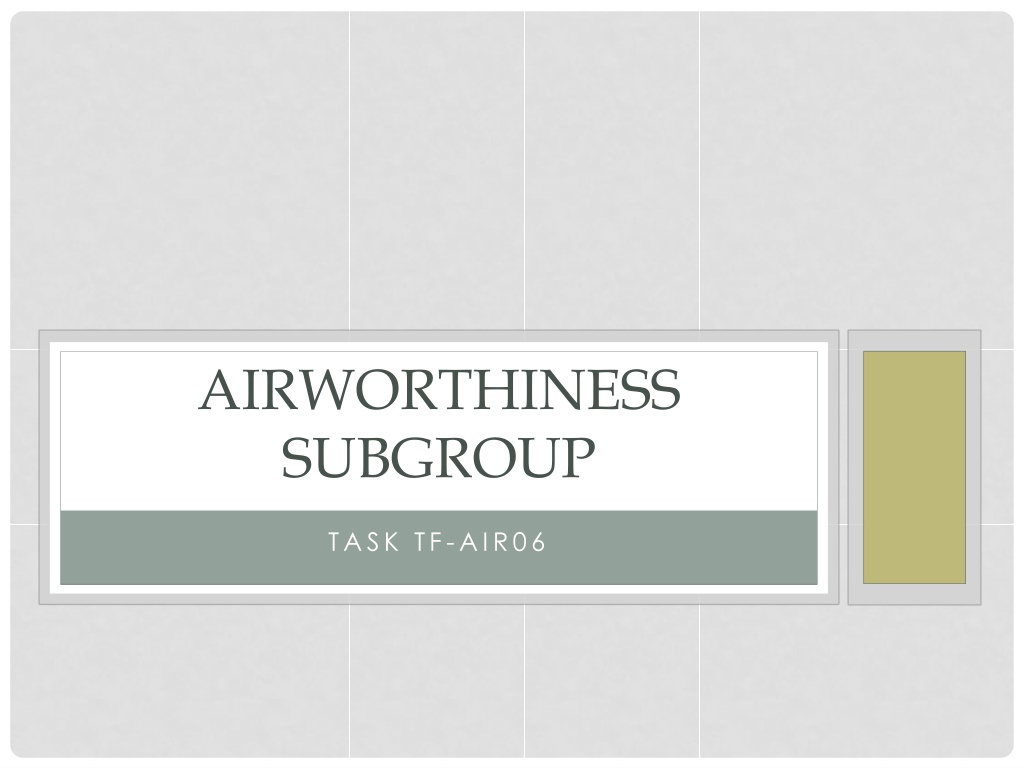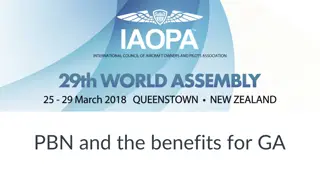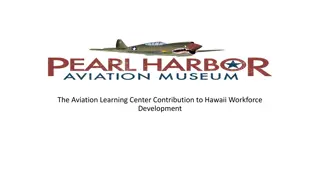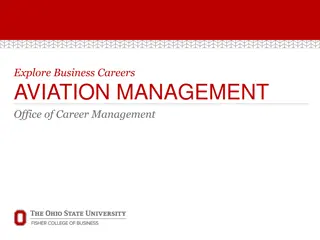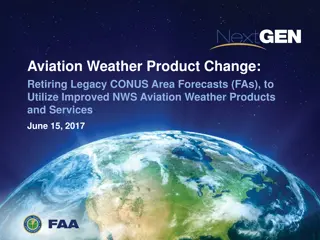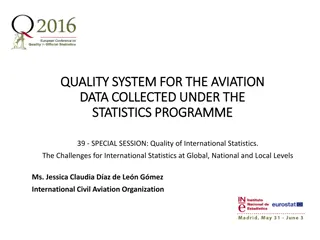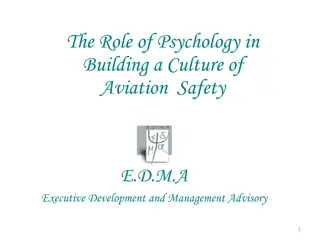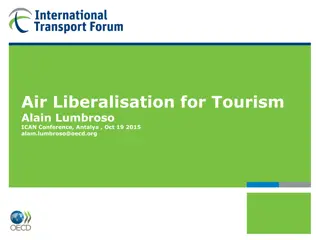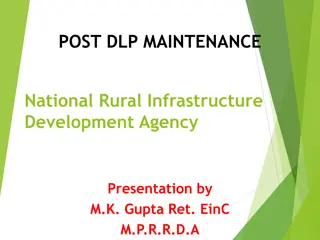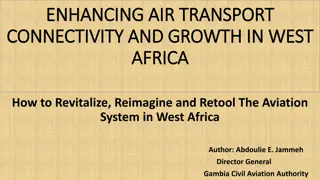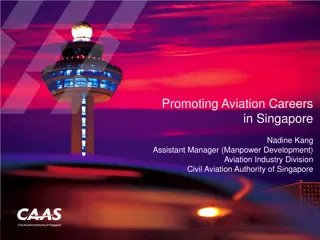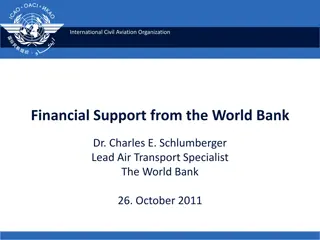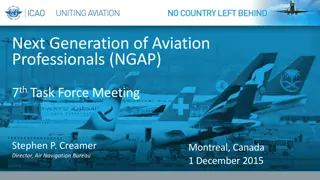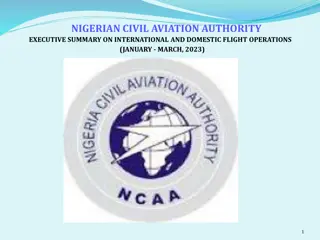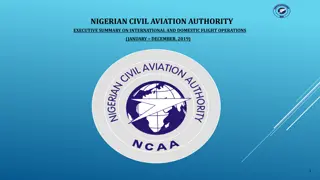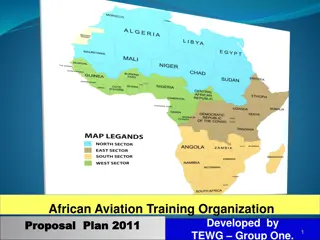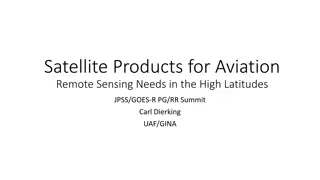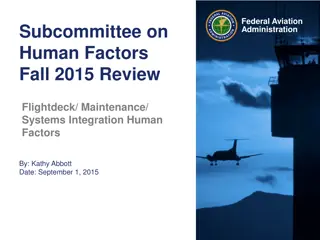Considerations for International General Aviation Maintenance and Operations
This document discusses maintenance and operational considerations for International General Aviation (IGA). It covers topics such as maintenance instructions, operations recommendations, and the involvement of various industry entities like OEMs, operators, and aviation authorities. The conclusion highlights the sufficiency of existing recommendations for IGA maintenance considerations, with a focus on the adoption of specific guidance material. It also addresses the potential benefits of applying a Safety Risk Approach to IGA operations.
Uploaded on Oct 04, 2024 | 0 Views
Download Presentation

Please find below an Image/Link to download the presentation.
The content on the website is provided AS IS for your information and personal use only. It may not be sold, licensed, or shared on other websites without obtaining consent from the author. Download presentation by click this link. If you encounter any issues during the download, it is possible that the publisher has removed the file from their server.
E N D
Presentation Transcript
AIRWORTHINESS SUBGROUP TASK TF-AIR06
CONSIDERATIONS FOR INTERNATIONAL GENERAL AVIATION 1) Maintenance ..(similar to commercial transport or not?) 2) Operations ..(to recommend SRA or not?)
TF-AIR06 MEMBERS FOR IVATF/4 General Aviation Manufacturer Association (GAMA) International Aviation Business Council (IBAC) OEMs (PWC, Cessna Textron, Bell Textron Helicopters) Operators (Bristow Helicopters) Authorities of States (CASA Australia, FAA, EASA) ICAO Technical Officers
RECALL: TF-AIR06 IVATF/2 FOR : COMMERCIAL AIRCRAFT Globally Engine & Aircraft OEMs issued instructions for maintenance & inspection when flying in airspace with a low contamination of ash Operators should follow those instructions Guidance of ICAO Doc 9691 was recommended to be improved with the knowledge gained in 2010- 2011 The guidance was proposed by TF-AIR01 and TF- AIR06 in IVATF/2
1) MAINTENANCE CONSIDERATIONS Also (globally) majority of OEMS for aircraft & engines that fall under the International General Aviation have issued instructions for maintenance & inspection In principle there is no difference how the commercial domain and the International General Aviation Domain have responded The group reviewed examples of OEM documentation issued on IGA products and reviewed the recommendations from IVATF/2 TF- AIR06, including the Appendix 3D)
CONCLUSION FOR MAINTENANCE CONSIDERATIONS FOR IGA: Appendix 3D of IVATF/2 Report and IVATF Recommendation 2/16 sufficiently addressed the aspects of the International General Aviation No further action is required than to adopt the Appendix 3D in the ICAO Doc 9691 guidance material
2) OPERATIONS CONSIDERATIONS Would IGA benefit from Safety Risk Approach as applied to the commercial transport sector? Early conclusion: exclude the recreational part of the IGA: It does not economically suffer; limited expertise to do SRA available; no serious negative effects expected in case of eruptions Operators with organisations that are required to have a Safety Management System as listed in the provisions of ICAO Annex 6 - Operation of Aircraft the group concluded that it makes sense to require/consider SRA as part of the Safety Management System
PROVISIONS OF ANNEX 6 PART II & III: Part II: International General Aviation Part III: International Helicopter Operations (commercial air transport) Annex 6 refers to: Safety Management Manual (SMM) ICAO Doc 9859 Chapter 4.3.6 discusses Natural Hazards Paragraph 4.3.6 c mentions Geophysical Hazards including volcanoes (as example) TF-AIR06 concluded: volcanic ash is or should be(as a safety hazard) an intrinsic part of the Safety Management System
REMAINING QUESTION: WHAT TO DO WITH OPERATIONS EXCLUDED FROM HAVING AN SMS AS PER ANNEX 6 PART II AND III? Not large turbojet Non-commercial helicopter operations Search & Rescue and medical emergency & evacuation operations with those aircraft / operations should be allowed with common sense regarding the specific nature of the operations. Practical Solution: some States think that the State can request a simplified form of SRA . The expertise is within the State to require a simplified SRA or not.
TEXT PROPOSED TO BE ADDED TO DOC 9691 (TO ALREADY EXISTING RECOMMENDATION FROM IVATF/2) Volcanic Ash shall - as a geophysical safety hazard be addressed as an intrinsic element of the Safety Management System as required per ICAO Annex 6 Part I Operation of aircraft Commercial Transport Aeroplanes, Part II International General Aviation Aeroplanes and Part III International Operation Helicopters - International Commercial Air Transport; Guidance on Safety Management Systems can be found in in ICAO Safety Management Manual Doc 9859 and ICAO Doc 9974, which specifically addresses the risk of operations in airspace contaminated with volcanic ash;
TEXT PROPOSED TO BE ADDED TO DOC 9691 (TO ALREADY EXISTING RECOMMENDATION FROM IVATF/2) For the types of operations which do not require an SMS, such as certain Search & Rescue or Medical Emergency or Evacuation operations, the States are recommended to consider the specific nature of the life- saving operations in order to allow for operations in emergency conditions in airspace contaminated with volcanic ash. A simplified safety Risk assessment with regard to the hazards of volcanic ash for these types of operations may be requested by the State of the Operator.
PROPOSED GUIDANCE FOR ICAO DOC 9691 INCLUDED ILLUSTRATIONS For susceptibility of fixed wing aircraft with turbofans . But nothing for rotorcraft TF-AIR06 recommends to include an illustration specific for rotorcraft (not in time for the deadline of this Working Paper) A revised WP will handle the issue after IVATF/4 so we can include an illustration
CONCLUSIONS OF TF-AIR06 FOR IVATF/4: In 2010 and 2011, the majority of engine and aircraft TC Holders for commercial transport aviation and International General Aviation issued, re-issued and updated their maintenance and inspection instructions with respect to operation in airspace with a low contamination of volcanic ash. It is advised that ICAO guidance should reflect on those instructions. The aspects of the International General Aviation are sufficiently addressed with the proposed amendment to ICAO Doc 9691 that was included at Appendix 3D of the IVATF/2 Report (and IVATF/2 Recommendation 2/16), and as presented as Appendix A to this working paper. Operation in airspace contaminated with volcanic ash should be addressed as an intrinsic part of the Safety Management System (SMS) as required by ICAO Annex 6 Operation of Aircraft, Parts I, II and III. For the types of operations which do not require an SMS, such as certain Search & Rescue or Medical Emergency or Evacuation operations, the States are recommended to consider the specific nature of the life- saving operations in order to allow for operations in emergency conditions in airspace contaminated with volcanic ash. A simplified safety Risk assessment with regard to the hazards of volcanic ash for these types of operations may be requested by the State of the Operator.
RECOMMENDATION Proposed additional text for inclusion in the Manual on Volcanic Ash, Radioactive Material and Toxic Chemical Clouds (ICAO Doc 9691) is presented at Appendix B to this working paper, as a supplement to the proposal formulated at IVATF/2 (Appendix 3A of the IVATF/2 Report and IVATF/2 Recommendation 2/15 refers). That, the IVATF invites the appropriate ICAO group to finalize and incorporate the proposed additional guidance material on standards that have resulted in safe operations during volcanic eruptions, as given at Appendix2 .. to this report, into the Manual on Volcanic Ash, Radioactive Material and Toxic Chemical Clouds (ICAO Doc 9691).
